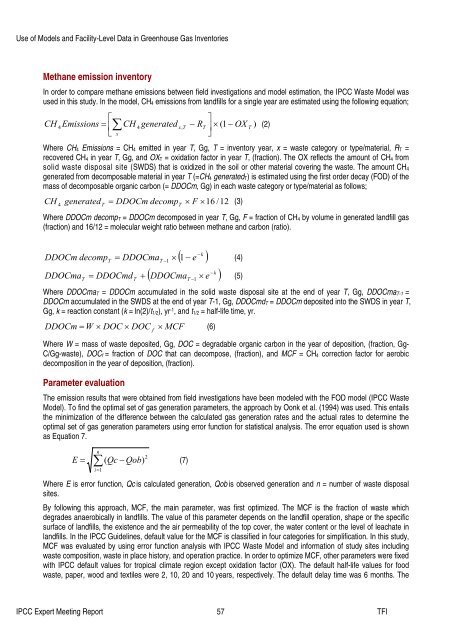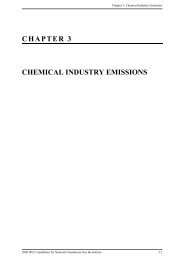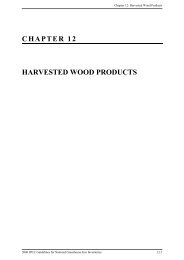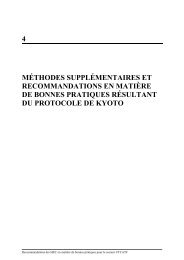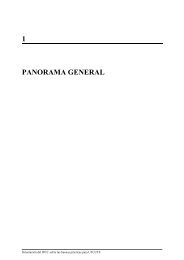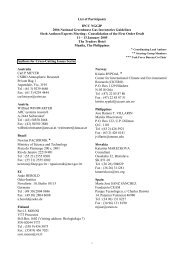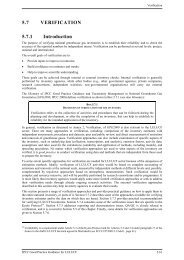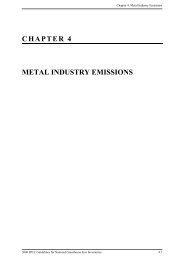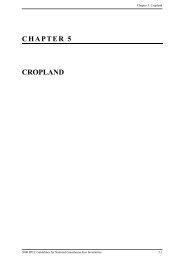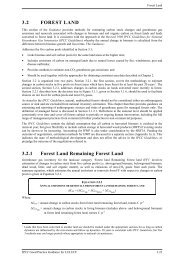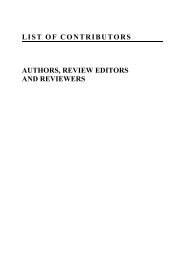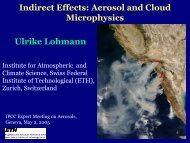Use of Models and Facility-Level Data in Greenhouse Gas Inventories
Use of Models and Facility-Level Data in Greenhouse Gas Inventories
Use of Models and Facility-Level Data in Greenhouse Gas Inventories
You also want an ePaper? Increase the reach of your titles
YUMPU automatically turns print PDFs into web optimized ePapers that Google loves.
<strong>Use</strong> <strong>of</strong> <strong>Models</strong> <strong>and</strong> <strong>Facility</strong>-<strong>Level</strong> <strong>Data</strong> <strong>in</strong> <strong>Greenhouse</strong> <strong>Gas</strong> <strong>Inventories</strong><br />
Methane emission <strong>in</strong>ventory<br />
In order to compare methane emissions between field <strong>in</strong>vestigations <strong>and</strong> model estimation, the IPCC Waste Model was<br />
used <strong>in</strong> this study. In the model, CH 4 emissions from l<strong>and</strong>fills for a s<strong>in</strong>gle year are estimated us<strong>in</strong>g the follow<strong>in</strong>g equation;<br />
⎡<br />
⎤<br />
CH<br />
4<br />
Emissions = ⎢∑ CH<br />
4<br />
generated<br />
x,<br />
T<br />
− RT<br />
⎥ × (1 − OX<br />
T<br />
) (2)<br />
⎣ x<br />
⎦<br />
Where CH 4 Emissions = CH 4 emitted <strong>in</strong> year T, Gg, T = <strong>in</strong>ventory year, x = waste category or type/material, R T =<br />
recovered CH 4 <strong>in</strong> year T, Gg, <strong>and</strong> OX T = oxidation factor <strong>in</strong> year T, (fraction). The OX reflects the amount <strong>of</strong> CH 4 from<br />
solid waste disposal site (SWDS) that is oxidized <strong>in</strong> the soil or other material cover<strong>in</strong>g the waste. The amount CH 4<br />
generated from decomposable material <strong>in</strong> year T (=CH 4 generated T) is estimated us<strong>in</strong>g the first order decay (FOD) <strong>of</strong> the<br />
mass <strong>of</strong> decomposable organic carbon (= DDOCm, Gg) <strong>in</strong> each waste category or type/material as follows;<br />
CH<br />
4<br />
generatedT = DDOCm decompT<br />
× F ×16 /12 (3)<br />
Where DDOCm decomp T = DDOCm decomposed <strong>in</strong> year T, Gg, F = fraction <strong>of</strong> CH 4 by volume <strong>in</strong> generated l<strong>and</strong>fill gas<br />
(fraction) <strong>and</strong> 16/12 = molecular weight ratio between methane <strong>and</strong> carbon (ratio).<br />
DDOCm decomp<br />
DDOCma<br />
T<br />
T<br />
−k<br />
T −<br />
× ( − e )<br />
−k<br />
( DDOCma e )<br />
= DDOCma<br />
1<br />
1<br />
(4)<br />
= DDOCmd +<br />
1<br />
(5)<br />
T<br />
T −<br />
×<br />
Where DDOCma T = DDOCm accumulated <strong>in</strong> the solid waste disposal site at the end <strong>of</strong> year T, Gg, DDOCma T-1 =<br />
DDOCm accumulated <strong>in</strong> the SWDS at the end <strong>of</strong> year T-1, Gg, DDOCmd T = DDOCm deposited <strong>in</strong>to the SWDS <strong>in</strong> year T,<br />
Gg, k = reaction constant (k = ln(2)/t 1/2), yr -1 , <strong>and</strong> t 1/2 = half-life time, yr.<br />
DDOCm = W × DOC × DOC<br />
f<br />
× MCF (6)<br />
Where W = mass <strong>of</strong> waste deposited, Gg, DOC = degradable organic carbon <strong>in</strong> the year <strong>of</strong> deposition, (fraction, Gg-<br />
C/Gg-waste), DOC f = fraction <strong>of</strong> DOC that can decompose, (fraction), <strong>and</strong> MCF = CH 4 correction factor for aerobic<br />
decomposition <strong>in</strong> the year <strong>of</strong> deposition, (fraction).<br />
Parameter evaluation<br />
The emission results that were obta<strong>in</strong>ed from field <strong>in</strong>vestigations have been modeled with the FOD model (IPCC Waste<br />
Model). To f<strong>in</strong>d the optimal set <strong>of</strong> gas generation parameters, the approach by Oonk et al. (1994) was used. This entails<br />
the m<strong>in</strong>imization <strong>of</strong> the difference between the calculated gas generation rates <strong>and</strong> the actual rates to determ<strong>in</strong>e the<br />
optimal set <strong>of</strong> gas generation parameters us<strong>in</strong>g error function for statistical analysis. The error equation used is shown<br />
as Equation 7.<br />
E =<br />
n<br />
∑<br />
i=<br />
1<br />
2<br />
( Qc − Qob)<br />
(7)<br />
Where E is error function, Qc is calculated generation, Qob is observed generation <strong>and</strong> n = number <strong>of</strong> waste disposal<br />
sites.<br />
By follow<strong>in</strong>g this approach, MCF, the ma<strong>in</strong> parameter, was first optimized. The MCF is the fraction <strong>of</strong> waste which<br />
degrades anaerobically <strong>in</strong> l<strong>and</strong>fills. The value <strong>of</strong> this parameter depends on the l<strong>and</strong>fill operation, shape or the specific<br />
surface <strong>of</strong> l<strong>and</strong>fills, the existence <strong>and</strong> the air permeability <strong>of</strong> the top cover, the water content or the level <strong>of</strong> leachate <strong>in</strong><br />
l<strong>and</strong>fills. In the IPCC Guidel<strong>in</strong>es, default value for the MCF is classified <strong>in</strong> four categories for simplification. In this study,<br />
MCF was evaluated by us<strong>in</strong>g error function analysis with IPCC Waste Model <strong>and</strong> <strong>in</strong>formation <strong>of</strong> study sites <strong>in</strong>clud<strong>in</strong>g<br />
waste composition, waste <strong>in</strong> place history, <strong>and</strong> operation practice. In order to optimize MCF, other parameters were fixed<br />
with IPCC default values for tropical climate region except oxidation factor (OX). The default half-life values for food<br />
waste, paper, wood <strong>and</strong> textiles were 2, 10, 20 <strong>and</strong> 10 years, respectively. The default delay time was 6 months. The<br />
IPCC Expert Meet<strong>in</strong>g Report 57 TFI


